Background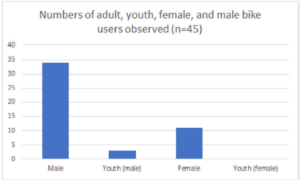
The Sacramento Area Council of Governments (SACOG) Transportation Committee makes policy for disbursing transportation related funds through grant programs such as the Regional Funding Program. Sacramento Regional Transit (SacRT) seeks funding from SACOG for modernization of its light rail system. The policy for the 2020 Regional Funding Program should include universal access to public transit vehicles. In March 2019, the Committee recommended, and the SACOG Board adopted, policy for disbursing remainder funds from the 2018 Regional Funding Program, capping, and thus, limiting the size of grant applications to spread funds widely across the region. Sacramento Regional Transit (SacRT) had requested $20 million for its Light Rail Modernization Project, including 20 new low-floor light rail vehicles, which provide universal access to light rail cars for any rider. The adopted policy resulted in reducing the amount of funds that could be sought for the light rail project, which means fewer, if any, low- floor vehicles can be purchased at this time. This delay will continue disadvantaging disabled, female, older, and youth bicycle users from accessing light rail.
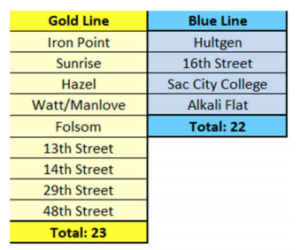
Table 1. Survey locations and total number of bike users observed.
SacRT’s light rail system has an annual ridership of 9.7 million and is the 16th busiest light rail system in the US. Unfortunately, the trains are critically outdated in their current design and fail to provide safe, secure, and universal accessibility to its ridership. Modernization is necessary to adequately serve the region’s growing population with diverse and changing transportation needs.
In regards to bicycle users, making light rail accessible to cyclists of all abilities is crucial for making longer-distance travel affordable and accessible; reducing auto traffic congestion; improving air quality, and reducing greenhouse gas emissions from the region. In order for the Sacramento Region to have these benefits, SacRT should be provided funding it requests to purchase low-floored light rail vehicles. Vehicles with lower ground level access allows universal access to all passengers, and in the case of the topic of this survey, bike riders of all abilities, size, and strength, would be able to easily and safely board trains with their bicycles.
The Survey
The 350 Sacramento Transportation Team observed and surveyed 45 passengers using bikes on SacRT’s light rail during May 2019. The survey team tallied the number of male and female bike users at several light rail stations and on board light rail cars, asking bike users about their points of origin, destination, and about the techniques they use to bring their bikes on board. Identifying the challenges bike users faced, and techniques they employed to use their bike in conjunction with a light rail trip, was a central goal of the survey. Our survey showed that without low-floor vehicles, women and youth are disproportionately disadvantaged from accessing light rail with bikes, and thus will likely incur more travel costs using autos for longer trips within the region, or not make the trips at all. The 350 Transportation Team is interested in supporting ways to make funding for low-floor light rail vehicles a higher priority for regional transportation funding.
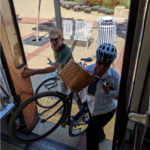
Folsom Station – Alison carrying a bike. Photo: Kat Gray. 5/5/2019

Folsom Station – youth with bike; the door kept closing on him. Photo: Kat Gray.
Our results show that male cyclists far outnumbered that of female and youth cyclists and that the higher cost of light weight bikes, and the technique and strength required to board a high- floor light rail train with stairs are likely reasons. Techniques for boarding light rail trains with a bike included lifting and carrying bikes over the shoulder, above the waist, or under the arm; resting the front wheel on each step while using ones arms to push and lift the bike upwards; holding train car doors open for one another; and buying or borrowing light weight or folding bicycles.
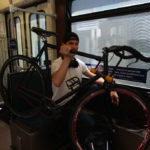
Young man demonstrates how he carries his bike over his shoulder to board and deboard the train. Photo: Glenda Marsh. 5/14/19.
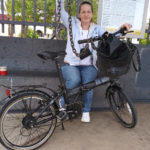
Dawn with borrowed folding bike and heavy bike chain and lock at Sacramento City College Station. Photo: Glenda Marsh. 5/14/19.
Due to the physical strength required to board the stairs on current light rail cars with a bicycle, women and youth face more obstacles to accessing this affordable public transportation option. Being able to travel longer distances often means access to better paying jobs, educational opportunities, and medical centers such as Veterans Administration hospitals, all accessible by light rail. Typically, light rail passengers are traveling farther to access jobs, schools, services, and medical care, and using a bicycle is a common means of getting to a bus, connecting to light rail, boarding a subsequent bus, and then riding the bike to a final destination. Light rail makes longer trips affordable.
Riders also discussed the limited bike rack supply and the lack of a designated area to stand with bikes secured. The crowding of bikes and people on a train car has led to injuries. Elderly and disabled riders risk injury when boarding and being seated among bikes, as well. In addition, weekend trains may consist of only one or two cars, leaving little room for bike users, who have to wait for the next train if the existing cars have several bikes on board already. 350 Sacrament recommends adding an additional car to weekend trains as a short-term mitigation for capacity.
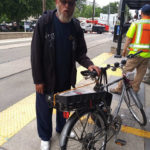
Michael once hurt his leg when bikes fell against it on board when the train suddenly lurched. Photo: Glenda Marsh. 5/14/19 16th Street Station.
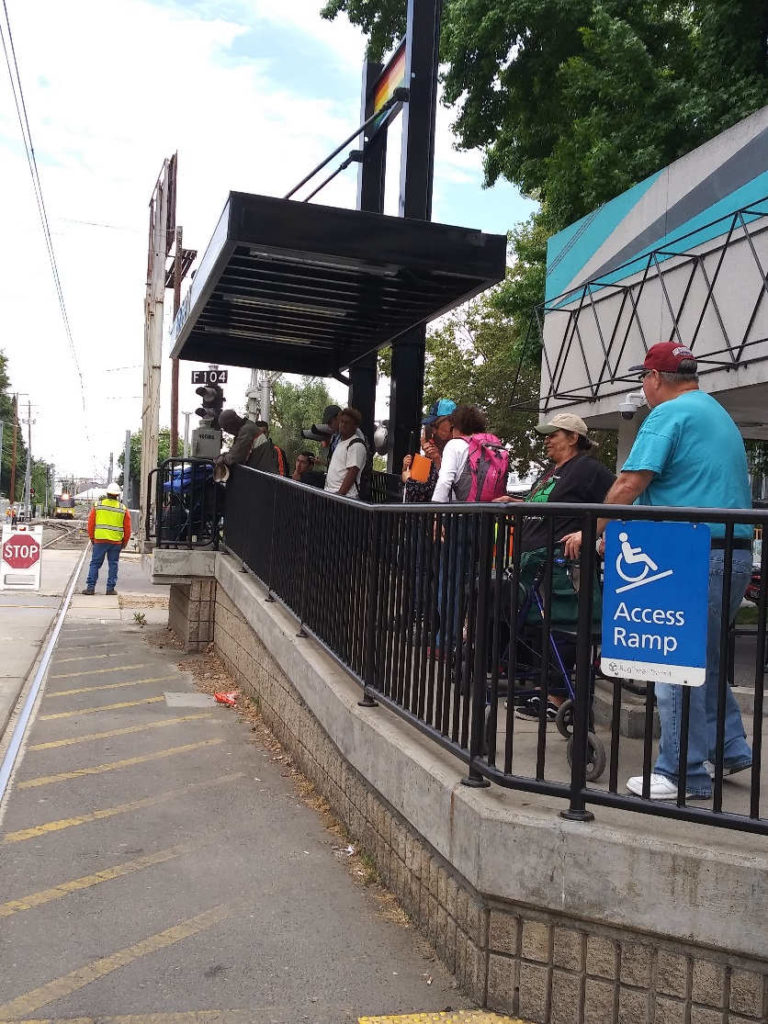
The access platform, reserved for disabled riders, is full at 16th Street Station; sometimes people ask why bicyclists don’t or can’t use the ramp to board, as well. Photo: Glenda Marsh. 5/14/19.
